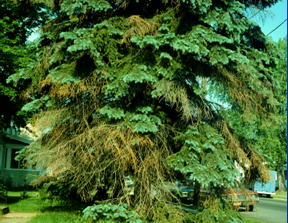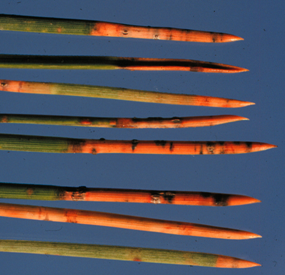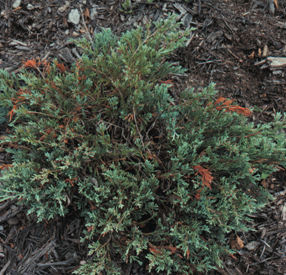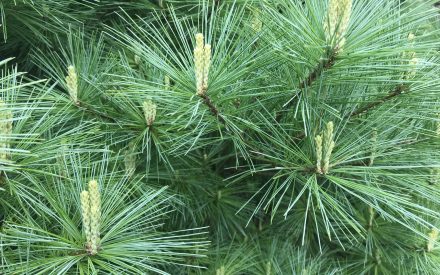
Brian Hudelson, UW-Madison Plant Pathology, UW-Extension
Revised: 3/11/2012
Item number: XHT1003
What is Cytospora canker? Cytospora canker is one of the most common fungal diseases of Colorado blue spruce. This disease can also affect Norway spruce (and less frequently other spruces) as well as Douglas-fir and balsam fir. Trees that are 15 years old or older and are at least 20 feet high most typically show symptoms of this disease.
What does Cytospora canker look like? Cytospora canker usually first appears on lower branches and progresses up the tree. Individual upper branches may show symptoms as well. Needles on infected branches turn purple, then brown and die. Diseased needles eventually fall off and the infected branches die. Infected branches often produce a bluish-white sap that oozes somewhere along their length.
Where does Cytospora canker come from? Cytospora canker is caused by the fungus Leucocytospora kunzei (also referred to as Leucostoma kunzei), which survives in infected branches. Spores of the fungus are spread by wind, rain splash, insects, birds and mammals.
How do I save a tree or shrub with Cytospora canker? Immediately remove and destroy any diseased branches, by pruning them using the 3-point method of pruning (see University of Wisconsin Garden Facts XHT1014 for details). Prune only in dry weather. Between cuts, be sure to clean your pruning shears by dipping them for at least 30 seconds in a 10% bleach solution or 70% alcohol (spray disinfectants that contain at least 70% alcohol can be used). This will prevent movement of the fungus from branch to branch, or from tree to tree during pruning. DO NOT attempt to use fungicide treatments to control this disease.
How do I avoid problems with Cytospora canker in the future? Perhaps the easiest way to avoid Cytospora canker is to avoid planting Colorado blue spruce. If you do plant blue spruce, allow adequate spacing between trees in new plantings. For established trees, judiciously prune branches to open the trees’ canopies. Proper spacing and pruning promote increased airflow, which leads to a less favorable environment for infection and disease development. In addition, minimize any stress to your trees. Prevent water stress by avoiding soil compaction, and by making sure there is adequate soil drainage. During dry periods, water your trees adequately (approximately one inch of water per week) using a soaker or drip hose. Proper mulching (one to two inches on a heavier, clay soil; three to four inches on a lighter, sandy soil) can help moderate your trees’ moisture levels. Prevent nutrient stress by properly fertilizing your conifers based on a soil fertility test. The University of Wisconsin Soil Testing Laboratories (http://uwlab.soils.wisc.edu/) can assist with soil and plant tissue fertility testing.
Download Article





 Conifer Disease Quick Reference
Conifer Disease Quick Reference Dothistroma Needle Blight
Dothistroma Needle Blight Phomopsis Tip Blight
Phomopsis Tip Blight Pruning Evergreens
Pruning Evergreens


